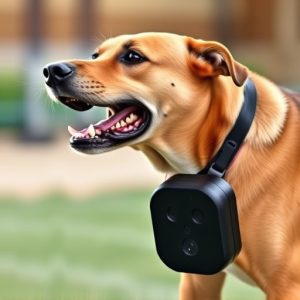Mastering Canine Behavior: Ultrasonic Systems for Optimal Dog Repellent Device Settings
Dogs communicate through vocalizations and body language, which can be harnessed for behavior modifi…….
Dogs communicate through vocalizations and body language, which can be harnessed for behavior modification using ultrasonic devices that emit high-frequency sounds. To choose the best vibration settings for a dog repellent device, consider individual dog sensitivity and adjust frequency ranges from moderate to intense based on their reaction. Target specific behaviors like barking or jumping with tailored frequencies, consistently reviewing and adjusting settings as your dog progresses. Place the device in problem areas, combine its use with positive reinforcement training, and gradually increase session durations to modify canine behavior effectively and humanely.
“Unleash the power of behavior modification with canine ultrasonic systems, a non-invasive approach to training. This article guides you through the science behind these devices and their effectiveness in addressing unwanted behaviors. We’ll delve into understanding canine psychology, exploring how specific ultrasonic vibrations can deter habits like barking or aggression. By learning the art of selecting the best vibration settings for your dog repellent device, you can achieve remarkable results with minimal effort.”
- Understanding Canine Behavior and Ultrasonic Systems
- Choosing the Best Vibration Settings for Your Dog Repellent Device
- Effective Implementation and Training Tips for Optimal Results
Understanding Canine Behavior and Ultrasonic Systems
Dogs, like humans, have unique behaviors and communication methods. Understanding a dog’s body language and instincts is key to effective behavior modification. Canine behavior often involves vocalizations, body postures, and movements that convey emotions and intentions. By observing these cues, owners can better interpret their pet’s needs and respond appropriately. For instance, a dog’s tail wagging or ear position can signal happiness or nervousness, respectively.
Ultrasonic systems have emerged as innovative tools in canine behavior modification. These devices emit high-frequency sounds, often inaudible to humans, that can be tailored to specific frequencies for different effects. The best vibration settings on a dog repellent device, for instance, might involve low-frequency ultrasonics that are uncomfortable for dogs but safe and imperceptible to humans. This technology allows for non-invasive training methods, such as deterring unwanted behaviors or reinforcing positive ones, by targeting the dog’s natural aversion to specific sounds.
Choosing the Best Vibration Settings for Your Dog Repellent Device
When selecting the best vibration settings for your dog repellent device, it’s crucial to understand that every dog is unique, with varying sensitivity and temperament. Begin by adjusting the frequency range, as different dogs may respond better to higher or lower frequencies. Start with a moderate setting and observe your dog’s reaction. If they show no signs of distress or avoidance, gradually increase the intensity until you find the optimal level. Consistency is key; use these settings regularly to reinforce the training.
Additionally, consider the type of behavior you’re targeting. For barking issues, a higher-pitched vibration might be more effective, as dogs are more sensitive to sounds in this range. If your dog has a tendency to jump or become overstimulated, opt for lower frequencies. Regularly reviewing and adjusting these settings based on your dog’s progress will ensure the repellent device remains effective and humane, catering precisely to their needs.
Effective Implementation and Training Tips for Optimal Results
For optimal results with a canine behavior modification ultrasonic system, careful and consistent implementation is key. Start by identifying the specific behavioral issue you wish to address—whether it’s excessive barking, aggression, or fear-based anxiety. Next, position the device in strategic locations where your dog frequently exhibits the unwanted behavior. This could be near entry points, beds, or areas where they tend to gather. The best vibration settings vary depending on the dog’s sensitivity and the behavior target, so experiment with different frequencies and intensities to find what works best for your canine companion.
Training should involve positive reinforcement techniques alongside device usage. Reward calm and desired behaviors with treats and praise while the ultrasonic system is active. Gradually increase the duration of sessions over time as your dog becomes more accustomed to the sound. Ensure training takes place in environments free from distractions, and maintain a consistent routine. Regular practice will help your dog associate specific triggers with the ultrasonic feedback, leading to modified behavior.
When it comes to using a canine behavior modification ultrasonic system, understanding your dog’s behavior and choosing the optimal vibration settings are key to achieving effective results. By carefully selecting the best vibration levels for your specific dog repellent device, you can ensure safe and gentle training that addresses unwanted behaviors without causing distress. Remember, consistent implementation and positive reinforcement training techniques will enhance the success of this approach, creating a happier, better-behaved canine companion.


